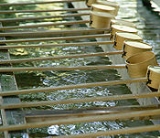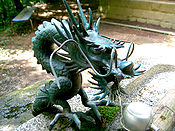
Chozuya
Encyclopedia
A is a Shinto
water ablution pavilion for a ceremonial purification rite known as temizu.
Water-filled basins are used by worshipers for washing their left hands, right hands, mouth and finally the handle of the water ladle to purify themselves before approaching the main Shinto shrine or shaden . This symbolic purification is normal before worship and all manned shrines have this facility, as well as many Buddhist temples and some new religious houses of worship.
The temizuya is usually an open area where clear water fills one or various stone basins. Wooden dippers are usually available to worshipers.
Originally, this purification was done at a spring, stream or seashore and this is still considered the ideal. Worshipers at the Inner Shrine at Ise still use this traditional way of ablution.

Shinto
or Shintoism, also kami-no-michi, is the indigenous spirituality of Japan and the Japanese people. It is a set of practices, to be carried out diligently, to establish a connection between present day Japan and its ancient past. Shinto practices were first recorded and codified in the written...
water ablution pavilion for a ceremonial purification rite known as temizu.
Water-filled basins are used by worshipers for washing their left hands, right hands, mouth and finally the handle of the water ladle to purify themselves before approaching the main Shinto shrine or shaden . This symbolic purification is normal before worship and all manned shrines have this facility, as well as many Buddhist temples and some new religious houses of worship.
The temizuya is usually an open area where clear water fills one or various stone basins. Wooden dippers are usually available to worshipers.
Originally, this purification was done at a spring, stream or seashore and this is still considered the ideal. Worshipers at the Inner Shrine at Ise still use this traditional way of ablution.

See also
- ChōzubachiChozubachiis a vessel originally designed to keep water for rinsing one’s mouth and cleansing one’s body before worshipping gods or Buddhas. It subsequently evolved into what is called and became a fixture of the Japanese tea ceremony found within the yard surrounding the tea house....
- The Glossary of ShintoGlossary of ShintoThis is the glossary of Shinto, including major terms the casual reader might find useful in understanding articles on the subject. Words followed by an asterisk are illustrated by an image in one of the photo galleries...
for an explanation of terms concerning Japanese Shinto, Shinto art, and Shinto shrine architecture.

